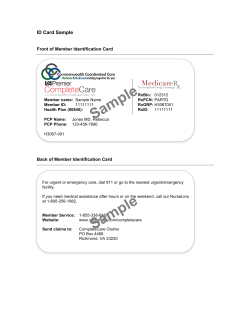
Oxygen Release Compound (ORC )
Case History O-13 Oxygen Release Compound (ORC®) PCP Bioremediation at Eastern Virginia DoD Wood Dip Tank Site SITE SUMMARY This site is the location of a former Department of Defense dip tank with associated storage racks that has been used to treat wood with a mixture of pentochlorophenol (PCP), diesel fuel and kerosene. The dip tank was dismantled in 1982 and the area was paved with asphalt and converted to a storage area. Subsequent soil and groundwater sampling indicated that PCP was present in both media, with soil concentrations greater than USEPA Region III Risk-Based Contaminant Levels and groundwater concentrations greater than USEPA Maximum Contaminant Levels (MCLs). In 1999, a soil excavation took place at the site removing all the soil above the water table with a PCP concentration greater than 16 mg/kg and the removal of one to three feet of soil below the water table. In 2000, a treatability study was conducted to evaluate the in-situ aerobic bioremediation) of PCP in the groundwater using Oxygen Figure 1. ORC Injection Release Compound (ORC®). REMEDIATION APPROACH ¾ Remediation Objective: Determine the efficacy of using ORC for the reduction of PCP concentrations in groundwater. ¾ Application Type: Grid (direct-push injection) ¾ Product: ORC ¾ Quantity Applied: 1,400 lbs ¾ Application Rate: Upper Aquifer: 6.3 lb/ft Lower Aquifer: 3.0 lb/ft ¾ Product Cost: $14,000 SITE CHARACTERISTICS General ¾ Name: DOD Wood Dip Tank Site ¾ Location: Eastern, VA ¾ Industry: Wood Treatment ¾ Contaminants of Concern: Well MW 21S MW 26S MW 27S PCP Concentration 450 ug/L 730 ug/L 460 ug/L Former PCP Dip Tank Cleanup Goal 1 ug/L Hydrogeology ¾ Treatment Area: 5,000 ft2 ¾ Soil Type: Fine to medium sands ¾ Groundwater Velocity: 0.3 ft/day ¾ Groundwater Flow Direction: Southwest ¾ Depth to Groundwater: 5.3 ft Oil Water Separator N Figure 2. Site Map All Rights Reserved 2004 Regenesis -1011 Calle Sombra, San Clemente, CA 92673 www.regenesis.com RESULTS Percent Contaminant Reduction Well MW 21S MW 26S MW 27S Post Treatment Concentrations Percent Reduction 71% 85% 96% Well MW 21S MW 26S MW 27S Concentration 130 μg/L 110 μg/L 19 μg/L Concentrations vs. Time Concentration (ug/L) PCP Concentration 1000 900 800 700 600 500 400 300 200 100 0 MW 21S MW 26S MW 27S 0 100 200 300 400 500 Time after Injection (Days) Monitoring for MW 26S did not occur at day 0. Monitoring for MW 27S did not occur at the first 3 sampling events (day 0, 55, 89) CONCLUSION The treatability study performed at the site validated the prediction that ORC-facilitated bioremediation could successfully degrade existing PCP concentrations. After 250 days of observation, sampling of the source well, MW-27S, indicated the successful degradation of PCP by 95.9%. Other wells further from the source also responded well to ORC treatment. Data for each well begins at different time periods following the treatment date because some wells were added after treatment occurred, specifically MW-26S and MW27S. Due to the likely remediation that took place before concentrations were monitored, it is hypothesized that initial concentrations and overall contaminant reduction in MW-26S and MW-27S were higher than existing data indicates. Therefore, it is assumed that the ORC treatment could have performed even better than data indicates. All Rights Reserved 2004 Regenesis -1011 Calle Sombra, San Clemente, CA 92673 www.regenesis.com
© Copyright 2025











